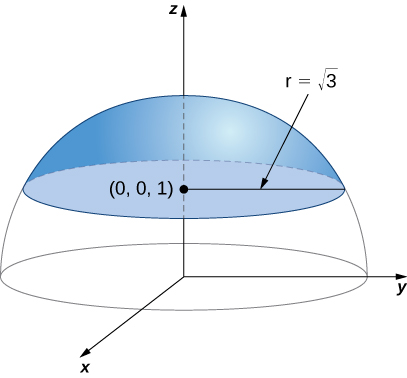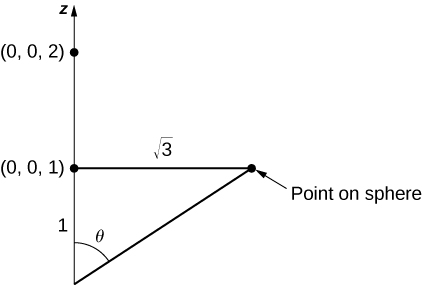| << Chapter < Page | Chapter >> Page > |
Calculate surface integral where and S is the surface that consists of the piece of sphere that lies on or above plane and the disk that is enclosed by intersection plane and the given sphere ( [link] ).

Notice that S is not smooth but is piecewise smooth; S can be written as the union of its base and its spherical top and both and are smooth. Therefore, to calculate we write this integral as and we calculate integrals and
First, we calculate To calculate this integral we need a parameterization of This surface is a disk in plane centered at To parameterize this disk, we need to know its radius. Since the disk is formed where plane intersects sphere we can substitute into equation
Therefore, the radius of the disk is and a parameterization of is The tangent vectors are and and thus
The magnitude of this vector is u . Therefore,
Now we calculate To calculate this integral, we need a parameterization of The parameterization of full sphere is
Since we are only taking the piece of the sphere on or above plane we have to restrict the domain of To see how far this angle sweeps, notice that the angle can be located in a right triangle, as shown in [link] (the comes from the fact that the base of S is a disk with radius Therefore, the tangent of is which implies that is We now have a parameterization of

The tangent vectors are
and thus
The magnitude of this vector is
Therefore,
Since we have
Calculate line integral where S is cylinder including the circular top and bottom.
0
Scalar surface integrals have several real-world applications. Recall that scalar line integrals can be used to compute the mass of a wire given its density function. In a similar fashion, we can use scalar surface integrals to compute the mass of a sheet given its density function. If a thin sheet of metal has the shape of surface S and the density of the sheet at point is then mass m of the sheet is

Notification Switch
Would you like to follow the 'Calculus volume 3' conversation and receive update notifications?